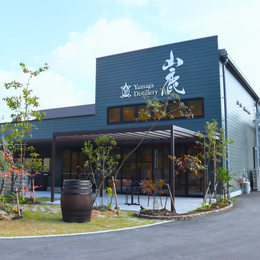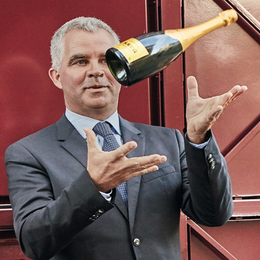This Is Yotaro Sasaki's nondo: From A Tiny Inn In Iwate Prefecture's Tono City Comes A Doburoku Sake That Even Michelin Chefs Want And Can't Have

Rice brewing has existed in Japan for thousands of years. Unexpectedly the methods and therefore the forms that it's taken has too evolved greatly along the way. Long before koji was understood, or how the moto fermentation starter was systematically made, and certainly before brewing with soft water, temperature controlled fermentation, rice polishing or kyokai Association standard issue yeasts, Sake took the ancestral form of a thick rice porridge known as Doburoku.
Much of Doburoku's recognisable form is primarily the result of not filtering the lees from the liquid alcohol - at the time, simply because such fine filtering techniques had yet existed. And so for centuries Doburoku was largely homebrewed and often part of spiritual rituals where the fermented rice mash was offered to Shinto deities in celebration of a good harvest, or simply enjoyed to mark a special occasion. Given the importance of rice in Japanese (and broadly Asian) society as the lifeblood of the people, to use rice for purposes other than for cooking and eating would have to necessitate a great reason, and therefore a worthy offering to the deities.
Nevertheless things changed and Doburoku became banned by the Japanese government in 1899. Whilst many reasons have been offered, ranging from quality control over homebrewing, rice rationing, as well as the desire to protect alcohol tax revenue, the longest standing reason has been the protection of the commercial Sake industry from competing homebrews. Sake production is responsible for many jobs in Japan, and yet has faced a multi-decade decline due to the lack of domestic interest as a result of changing preferences, perception, as well as a greater attraction to foreign alcoholic beverages. Yet as the Japanese government went through the entire roulette of initiatives that have been touted as potentially being able to reverse the decline in Sake consumption locally, it eventually found itself right back at the start - that perhaps it was time to re-open Sake production to new (old) styles that could reinvigorate interest once again. And so in 2002-2003, the Japanese government would single out special deregulation zones where Doburoku could be produced again, hoping to revitalise particularly vulnerable rural areas of Japan that were especially under threat of depopulation.


Historically a rural and harsh landscape, Tono was selected as the first Doburoku Special Zone in a bid to revitalise the local economy.
The first Doburoku Special Zone (DSZ, as it is called) was announced to be Tono City in the Iwate Prefecture, equidistant between Tokyo (in the center of Japan) and Hokkaido (the northern tip of Japan).
And so it is here in Tono, which sits in a basin that pretty much freezes over for 6 months of a year, that we find Sasaki Yotaro (佐々木要太郎) who serves as the fourth-generation to run the family's little inn Minshuku Tono (which translates as Tono Guesthouse), and is also where Sasaki also runs the famed Tonoya-yo kaiseki restaurant and produces his cult Doburoku under the name nondo.

Yotaro Sasaki (佐々木要太郎) had dreamed of being a salaryman with a stable life, and yet would go on to redefine sustainable farming, Sake-making and the local culinary craft.
For someone who has pretty much defied all odds to make an internationally recognised name for himself all from his family's little guesthouse sat in rural Tono, it's surprising then that Sasaki had initially wanted anything but this. Growing up around the family's inn, Sasaki would often find his family working long hours without ever having any days off - he wanted nothing of it and thus decided to leave for an office job in a bigger city; a salary and a stable life was the dream. Nevertheless in 2002, when it was announced that the rural town of Tono was in fact selected to be the first Doburoku Special Zone, Sasaki's father would quickly call for Sasaki's help to capitalise on the government initiative. "My father seemed to think he'd be an administrative worker in charge of license applications, but I myself became fascinated with fermentation." says Sasaki, tying it to his own start into the world of fermentation, "Working with invisible bacteria, we create a different form of Sake from rice. Solids turn into liquid! And unlike wine, it's a process of multiple parallel fermentation, where saccharification and alcoholic fermentation occur simultaneously. I was excited by this!" Finding out that the concept of multiple parallel fermentation was unique to Japan, Sasaki was confident that Japanese Sakes could hold its own amongst the liquors of the world.
Yet it wasn't smooth sailing right from the get go, as Sasaki would quickly find out that fermentation, and by extension Sake-making, or even simply taking over the reins to the family's inn, was alot more challenging than he could have imagined. Sasaki would begin growing his own rice and jumped in headfirst to brewing Sake without much prior experience, which he would serve at his family's guesthouse.

"On June 23 about 18 years ago – I remember the date because it was my birthday – a guest I was serving at the minshuku happened to be a respected toji (Sake brewmaster) visiting from Niigata. He basically tore my work apart; he pulled me aside and said, ‘You can’t be serving this stuff. What you’re making and what I’m making come from the same place – water, rice and koji. You have a responsibility to do better.' I had started because I was attracted to the historical background, but I still didn't understand the 'taste'." Sasaki recounts.
This was a wake-up call that made Sasaki realise that there was no space for amateurism or half-heartedness when it came to Sake-making - if he was to make his own Sakes, he would have to go all in.

Sasaki would begin studying Sake brewing at the Industrial Technology Centre of Iwate Prefecture for the next 3 years, as well as seek advice from the Brewing Society of Japan in Tokyo - and yet whilst he did learn Sake brewing, there was little that these institutions could do to help Sasaki where it came to brewing Doburoku. For Sasaki, Doburoku was deeply important not just because Tono had opened up to the style, but that in fact Doburoku had been brewed in the harsh climate of Tono for centuries. Long before technologies existed to allow for the storage of produce, locals had to learn how to ferment their ingredients in order to survive, and thus Doburoku had long been deeply intertwined with the local culture of Tono. Where Doburoku was largely considered crude and rudimentary, Sasaki saw great potential for a style he resonated with.
"If Sake is the front, Doburoku is the backstory"
Quoting a local proverb "Shiroki Kuroki", which can be translated as "White Sake, Black Sake", Sasaki explains that Shiroki (or "White Sake") refered to Doburoku, drawing upon the appearance of the white coloured rice mash, whilst Kuroki (or "Black Sake") refered to the more classical filtered Sake which was in the past filtered using black charcoal (hence "Black"), and hence the concept of Doburoku Sake alongside classical clear Sakes were in fact once widely accepted as being two halves of a whole, that was until the Westernisation of Japanese cuisine had imposed particular ideals that would see Doburoku's disappear. As the style of sake faded away, so too did the ancestral knowledge of brewing Doburoku.

Sasaki's multi-generational guesthouse.
And so even after having formally studied Sake brewing, Sasaki was advised to apprentice at a brewery that could help him to learn Doburoku brewing. Sasaki would soon learn that finding a brewery to train him was near impossible as no one wanted to help create a potential competitor in an already declining market. Yet, one fateful night a well-known fisherman by the name of Koichi Mura was over at Sasaki's guesthouse when Sasaki would broach the topic of wanting to apprentice at a Sake brewery to no avail, which to Sasaki's surprise, Mura would help introduce Sasaki to the well established Kubo Honke brewery in Nara! This gave Sasaki the opportunity to train for 10 days with Kubo Honke's brewmaster, Kato. This proved to be a major moment of enlightenment for Sasaki.

Making the Shubo yeast starter with the ancestral Kimoto method at Kubo Honke.
Sasaki had initially entered Kubo Honke simply wanting to learn the most commercially standard form of Sake brewing, Sokujo, and simple koji-making, hoping to at the least bring back with him a fixed recipe for Sake-making. Yet he would instead be taught the ancestral Kimoto method, where he was shown that in order to make quality Sake, sticking to technical standards was insufficient, and that it was instead more important to focus on a concept known as full fermentation Sake, where true Sake brewing starts long before the rice is even fermented and long after the Sake has been fermented. “Particularly when it comes to Doburoku, when we can’t separate the liquid from the rice solids, achieving that full fermentation is critical in order to produce something that’s a complete and true expression of the rice, and that is also able to satisfy as a beverage in the same way that sake can. Kubo Honke’s Kimoto no Dobu is brewed envisioning what it will become at least three years down the road. For their standard Kimoto Junmai, they’re thinking at least 10 years into the future.” marvels Sasaki.
This prompted Sasaki to begin seriously examining the rice he was using for his Sake-making, which he felt was the cause of a poor yeast to koji ratio. This was also further compounded by the requirement set forth by the special license for Doburoku-making which only allowed brewers to use rice that they had grown, further emphasising the importance of Sasaki's ability to grow quality rice.

Sasaki had nevertheless by then already developed some intuition to do with the subject, having been a big wine lover during his time working an office job. He had been fascinated with the work of French Burgundian legend Henri Jayer, and the biodynamic teachings of Rudolf Steiner and Japanese natural farmer and philosopher Masanobu Fukuoka, and thus had a deep appreciation for sustainable farming and how it translated into incredibly special and unique wines. Sasaki would later find that sustainable farming was also very much intertwined with the Japanese concept of Onmyodo, or the Yin and Yang forces that govern nature - it resonated with Sasaki, yet till that point he had felt that he still lacked the experience to give these ideas conviction.
“I’m the type of person that in order to convince myself I’m doing the right thing, I need to personally go through the process of engaging in not only the path that I’m hoping will prove to be the best option, but all of the alternatives as well,... I spent three years cultivating rice across a number of fields, engaging in ranges of both standard and unconventional growing practices. I grew rice in the way most farmers do in this country, respecting yield but not the soil, but also worked organic rice fields alongside fields that would go above and beyond the conventions of organic.”

His early efforts with using the more common Akita Komachi rice variety did not offer enough of a sense of place for Sasaki, whilst the strict adherence to the teachings of natural farmers that Sasaki had looked up to had also produced lacklustre results. And so Sasaki would begin to chart his own course, having concluded that the special climate and terroir Tono would simply require its own tailored methods. His research would lead him to finding records of the use of a historical rice variety known as Tono Ichigo (or Tono #1), a table rice that was first used in 1939 but was no longer farmed as a result of a standardisation of consumer preferences post-WWII. Getting his hands on just 5 grams of preserved Tono Ichigo seeds, Sasaki would begin the arduous work of re-cultivating the rice variety. It would take him 6 more years before he could finally accrue sufficient scale that would allow him to use the local rice variety for his Doburoku's.
At the same time, his efforts in natural farming and the avoidance of any chemical fertilisers or pesticides, had begun to rejuvenate the health of the soils, which in turn began to show positive signs as his Tono Ichigo rice crops grew successfully and a bustling biodiversity had taken root. "Right from the start, I was convinced that pesticides and fertilisers weren’t necessary for rice production, but I couldn’t unilaterally deny them without understanding the experience of farmers. It was obvious from looking at the quality of the rice, the impact on the land, and the resulting quality of the Doburoku that growing rice using conventional modern practices was not the path forward... Native varieties are suited to the land. I experienced this by growing them myself. When the soil is healthy, the types and quantities of weeds change. People are amazed when they see my rice fields." reflects Sasaki.

He would also begin to cultivate his soils with gentler methods, eschewing the use of heavy and large scale machinery to prevent damage to the soils, whilst also incorporating sustainable water management that helped to prevent weeds and pest from taking over. Sasaki would also spend well over a decade learning the particularities of each parcel of soil so that he is able to determine what types of soils would work best, in turn creating a conducive environment for healthier rice and crops. Where possible, Sasaki would even request to help rejuvenate the soils of other farmers, with the hopes of inspiring other farmers to adopting the same methods and philosophy as he's himself developed.
Having redesigned his entire farming process over the course of a decade, Sasaki began to observe a palpable change in the fermentation process of his sustainably grown rice - fermentation cycles were longer, which Sasaki explained was a positive sign that the natural yeast too had become stronger, which allowed for a more synergistic dynamic between the yeast and lactic acid bacteria, creating a Doburoku Sake that could even withstand ageing in the bottle, an ideal once considered unthinkable! Today, Sasaki even utilises the ancient mizumoto method (where rice is first soaked in water to promote lactic acid fermentation, with the water saved and reused for the Sake brewing) to ensure that the yeast is able to survive in bottle even when shipped overseas, a tidy effort simply so that the world can better appreciate Doburoku.

Yet, having disappeared for decades, Doburoku in the early 2000's was still poorly understood and even more less appreciated. It was said that in past, a rudimentary understanding of fermentation would simply have farmers store pots of Doburoku in the snow whilst it was still sweet, where they would then return in spring when the snow had melted and by then, the Doburoku had now become sour. Nevertheless, as the Doburoku represented the prize of the harvest, it was still revered as precious even if not particularly tasty. And thus Sasaki understood that even if he had nailed the most optimal sustainable farming methods to produce the best rice possible from his land, the final product still had to be good in order for the style to be taken seriously. Where it was wild, funky and inconsistent, Sasaki would have to figure a method to refining how Doburoku was made - all with little to no guidance. The process would take Sasaki another decade of trial and error.
“The general perception is that Doburoku is a more ‘simple’ or ‘primitive’ form of Sake, but what people don’t realize is that having the option to press the mash is actually an incredible luxury. Sake breweries are able to select the precise time that they want to press, essentially capturing the Sake in its ideal state. We don’t have that luxury. We’re making a living thing that, even when complete, keeps on living, and it has to be good – and remain good – every time. It requires a whole other level of planning. That’s why I had to build my entire process, literally from the ground up. I didn’t select my farming methods merely because they skewed more ‘natural’. I settled on it because I realized that it’s essential in order to create a style of Doburoku that I could be proud of; not in spite of the production limitations, but because of them.” says Sasaki. It is therefore thanks to his tireless work over more than two decades that what was once seen as crude, rustic and overly funky, has become better understood as elegant, historic and artisanal.

Akameshi is a spontaneously occurring effect where the rice turns red upon steaming as a result of its natural farming.
To make his Doburoku, Sasaki first matures all of his rice grains for an average of two years before a single grain is actually used in the brewery. Then once ready, the rice is further soaked for another two weeks before Sasaki uses the kimoto (where a small sample of mash is constantly pounded to allow for spontaneous natural fermentation that then becomes the shubo or yeast starter) or mizumoto methods to create the yeast starter for brewing. Whilst Sasaki's Doburoku today makes use of rice grains that are only polished to 98% (hence only 2% of the rice grain is removed), this was in fact an evolution over the years where he had, like many others, started out with polishing his rice down to about 50%. Conventional Sake-brewing philosophy typically touts a higher rice polishing ratio as an indicator of quality, with as much of the rice grain removed to leave but the shinpaku (the starchy core of the rice), which is said to allow for purity of aromas and flavour, with the more earthy exterior seen as undesirable. Sasaki would once again experiment with various rice polishing ratios, each batch made with a 5% difference in rice polishing, leading him to initially conclude that a 60% rice polishing ratio was ideal. This sufficed for years until he once had the inspiration to polish his rice minimally, keeping 98% of the rice grain (the same as table rice that is typically eaten), and had realised that no one could notice the difference. As a result, Sasaki has kept at that level ever since.
Once brewed, Sasaki allows the Doburoku to age for 3-6 months before bottling the rice mash alive and unpasteurised, giving way for a sparkling texture and singular flavour to be achieved over time as it continues to evolve in the bottle. Nevertheless, Sasaki remains resolute that the most important factor to his brewing is still the quality of the soil from which he farms his rice.

It is this twenty plus year work that Sasaki then names nondo. The name itself is derived from two meanings in Japanese, the first of which is "noto" which refers to farmers, and the second is "nondo" which refers to the drinker. For Sasaki, his Doburoku's are two halves of a whole, with both the farmer and the drinker coming together.
More recently, Sasaki has begun to also emphasise sustainability through the use of every single part of the rice grain, which has in turn led to his creation of a Sake-like drink he calls Rice Bran Craft Sake (権化) that is made by fermenting the rice and bran (which would otherwise be discarded) separately whilst still using the koji. The result is a clear yet deep golden alcohol is described as umami, complex, and comparable to Spanish Sherry.

It's worth noting that above and beyond his pioneering work in the fields of farming and creating the ideal Doburoku, Sasaki had also in parallel learnt Japanese cuisine from his father who was also a chef. Much like his journey with farming and Doburoku-making, Sasaki had similarly started out making Japanese food in a style that was familiar to what could be experienced in larger cities such as Kyoto. Yet, it was ultimately a chef who had been a guest at Sasaki's guesthouse who had encouraged him to create something unique that could not be enjoyed anywhere else - otherwise, there would be little reason for someone to venture this far out to a rural place like Tono. Sasaki would thus decide that if the best salami was already known to come from places like Italy, he should instead focus on refining and conveying what Tono uniquely had to offer. Drawing inspiration from his great-grandfather who was a hunter, Sasaki would thus carry on the tradition of making dried meat preserves that is instead familiar to those from Tono.
Today, guests as Sasaki's minshuku enjoy a multi-course meal entirely prepared by Sasaki with just the help of one assistant. Dishes such as nama-fu, a traditional wheat gluten cake, as well as preserved hoya (sea squirt) bottarga, are served with local hitsumi wheat noodles, which are of course to be enjoyed with Sasaki's Doburoku, giving a true taste of Tono.

Sasaki's tireless efforts in perfecting his cuisine are today widely recognised both domestically and internationally. His work has quietly set forth a agricultural revolution that has begun to take hold not just in Tono but in fields across Japan (now expanding with the Doburoku Farmers Project), with also the Doburoku style of Sake increasingly appreciated and prized; even Sasaki's family guesthouse has become listed as one of the best 50 restaurants of the world. Nondo Doburoku has since been famously served at Michelin restaurants such as Mugaritz and Disfrutar, where it has even been featured as the star of seasonal menus created around the Sake itself. Yet, for Sasaki, his focus remains firmly on keeping his Sakes local, with little desire to push for international sales as he wants people to come to Japan and enjoy what the country has to offer.
It's incredible to think that all of this came as the result of one man's work and relentless willingness to reinvent in the pursuit of perfection, emanating from a little guesthouse set in the remote rural farmlands of Japan, a place one considered so harsh that the government had singled it out for desperate revitalisation. Yet in the most challenging of environments, Sasaki has proven that greatness can be found if one dares to reject conformity and wear proudly its uniqueness. It is here in Tono that the lost and ancient art of Doburoku-making has therefore been revived.

"I worked on it for 10 years, almost without sleep, completely absorbed in it. It's the moment when rice grains ferment and turn into liquid, or when you cut the cheese curd. I still get thrills from it. Maybe to an extent I enjoy it. I think that more than anything, whether it’s rice-growing or sake-making, those are worlds where there’s no end to the discovery. The learning and the possibilities are infinite, I think that’s the true appeal. It’s knowing that I’m engaging with something that I could never possibly hope to have all the answers to that I think really drives me.”
Yotaro Sasaki
PS. Big shoutout to Omu Nomu Craft Sake & Raw Bar and Alex for constantly bringing to Singapore the most incredible and inspiring craft Sakes!
Kanpai!

@111hotpot





